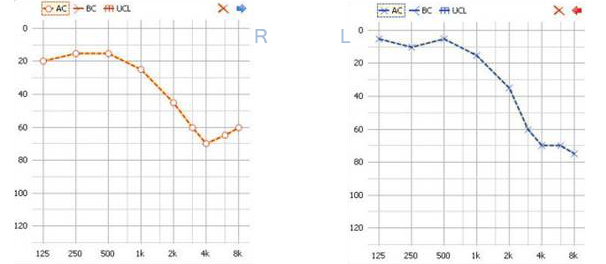Speech Testing – What is it?
Often the first sign that your hearing levels are not what they used to is when the speech you hear from other people seems to have changed. You complain everyone is mumbling! You may hear the words, but not be able to distinguish what is being said, particularly in noisy places.

For some people, this is happening even in quieter situations. For this reason, a hearing test will also involve checking not only how well you hear pure tones, but also how well you distinguish speech.
The speech test carried out during your hearing test is also known as speech audiometry or speech discrimination testing. It’s a method of measuring your ability to recognise speech. The information received from this test will help your Hearing Health Clinician determine how well you hear speech and interpret simple speech sounds. This test can be carried out in a quiet environment with no competing noise, or it can be completed in noise – to determine how you fare in noisy situations. For this test, instead of listening to varying tones of pitch and loudness, you’ll be listening to simple words at differing loudness levels. You’ll be asked to repeat the words that you hear. The clinician will record your responses to the words and evaluate them against normative results.
In Australia, the most common speech test involves listening to lists of 10 single syllable words. After each word you will repeat back the word you hear (or part of the word – all responses are important). The speech test will start at an easy-to-hear level and each subsequent list will get louder and/or softer – depending on what the clinician is assessing in your speech discrimination. Some words will be very difficult to hear, no matter what your hearing level is. That’s okay – the clinician wants to know everything you hear, even if it sounds like nonsense. The single syllable 10 word lists are called the “AB (which stands for Arthur Boothroyd – who developed this test) word lists” and standardised for Australian speakers. The voice you hear saying the words may be male or female.
The results you achieve will be compared against your pure tone hearing test (audiogram) and help your clinician determine your speech discrimination level (either ‘excellent’, ‘good’, ‘fair’ or ‘poor’).

It will also tell the clinician your speech reception threshold – or where speech is just audible for you. This information informs how well you hear and understand speech at normal conversation levels. This is useful information when selecting a hearing aid. A high score doesn’t reflect your pure tone levels, but indicates how you hear with amplification. If you need to augment your hearing levels, this is good news – it means you’ll hear well with hearing aids.
Speech testing can also give important information on your type of hearing loss and be used by a medical practitioner as part of a range of diagnostic tools to interpret why you have a hearing loss. It can also be used to determine where you find sounds uncomfortably loud, which again, is useful data when setting up your hearing aids.
Need Help Finding Hearing Aids?


